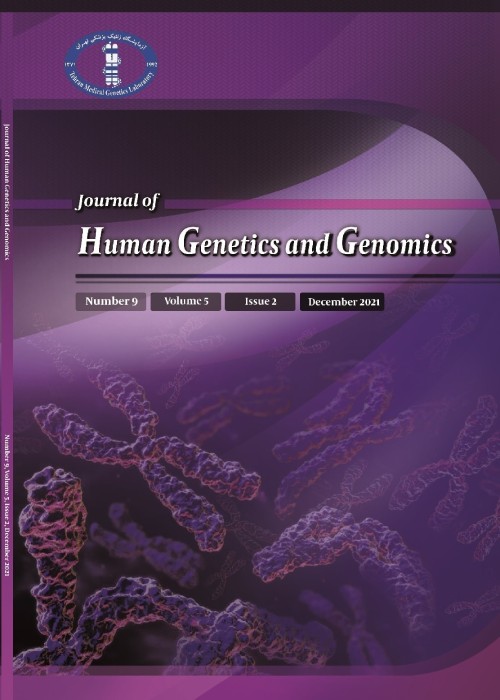فهرست مطالب
Journal of Human Genetics and Genomics
Volume:2 Issue: 2, Dec 2018
- تاریخ انتشار: 1398/11/15
- تعداد عناوین: 5
-
-
Page 1
In the last two decades, stem cell therapy has been developed rapidly. Stem cells have now emerged as a new treatment for many major disorders including neurodegenerative diseases such multiple sclerosis (MS). Recently, the attention of researchers working on MS have been attracted to cell therapy using therapeutic stem cells (TSCs). In this brief narrative review we explore the application of TSCs in last 5 years registered clinical trials. At the end, we will discuss the challenges and hopes ahead of therapeutic stem cells in treating MS patients.
Keywords: Clinical Trial, Stem Cell, Multiple Sclerosis, Cell Therapy, Therapeutic Stem Cell -
Page 2Background
PRODH is one of the genes that exists in 22q11.2 location and encodes the prolin oxidase enzyme (POX) in the mitochondrial inner membrane and is expressed in the liver, kidney and brain. The importance of the accompaniment of the PRODH gene’s polymorphisms and mutations in increasing the risk of getting afflicted with schizophrenia has been proven in previous Linkage and Association studies. Proline dehydrogenase enzyme (POX) accelerates the converting of prolin into glutamate. Decreased enzyme causes hyperprolinemia resulting in increased proline and decreased glutamate. The activity of NMDA and AMPA receptors decrease and low activation of these receptors cause negative symptoms of schizophrenia disorder. V427M mutation in PRODH has been proven to decrease pox enzyme activity and is associated with schizophrenia disorder.
ObjectivesIn this project the rs2238731 variant in the PRODH gene was genotyped in 95 schizophrenic patients whose diseases are psychiatrically confirmed and also in 120 healthy people without any history of schizophrenia and bipolarity in their pedigree. For this purpose, their peripheral blood was taken.
MethodsIn this study, the PCR-RFLP approach has been adopted in order to identify this variant. The SPSS 24.0 software has been used in order to statistically analyze the association of mutant variants and normal variants among the two groups afflicted with the disease and non-afflicted with the disease. The goal of this study was to shed light over the accompaniment of the rs2238731 variant in the PRODH gene with the risk of getting afflicted with schizophrenia among the Iranian patients.
ResultsAccording to our result, there is no association between V427M missense mutation and schizophrenia disorder in Iranian patients. So the V427M missense mutation could not be regarded as co-related with increasing risk of schizophrenia in Iranian patients.
Keywords: Schizophrenia, Single Nucleotide Polymorphism, Proline Dehydrogenase -
Page 3Background
Chronic exposure to benzene or its derivative (benzoquinone and hydroquinone) in humans may result in bone marrow damage followed by development of leukemia. Induction of extra cellular signaling pathways in microenvironment of bone marrow of patients with acute myeloid leukemia (AML) may lead to progression of disease and treatment resistance. Mesenchymal stromal cells (MSCs) are a subpopulation of multipotent cells of non-haematopoietic origin. They are increasingly recognized as a central component of the bone marrow (BM) microenvironment that contributes to the structure and function of the BM niche. MSCs play significant roles in regulation of homing, self-renewal, differentiation, and proliferation of hematopoietic stem cells (HSC) through production of various crucial elements in hematopoietic niche. Niches are local tissue microenvironments that maintain and regulate stem cells. Previous studies have shown that benzene is one of the important risk factors for AML.
ObjectivesThis study aimed to evaluate the effect of low doses of benzoquinone on the expression levels of some hematopoietic function related genes including CXCL12 and Kit ligand (KITLG) in MSCs.
MethodsMSCs obtained from bone marrow mononuclear cells of healthy volunteer and cultured in the proper medium. After characterization with standard methods, MSCs were exposed to two doses of 5 and 10 micro molar (µM) of benzoquinone; then, the expression of KITLG and CXCL12 genes were evaluated by real time PCR method.
ResultsThe results indicated that the expression of KITLG and CXCL12 genes were increased after treatment with benzoquinone, specifically with 5 µM dose.
ConclusionsThe results of our study along with well-established role of KITLG/SCF signaling pathways and the CXCL12-CXCL4 axis in maintenance of the niche and cancer development, benzene metabolite, benzoquinone, is among the major factors in causing acute myelogenous leukemia.
Keywords: Chemokine, Benzene, CXCL12, Kit Ligand -
Page 4Background
Short tandem repeat (STR) markers are extensively being used for human identification as well as paternity and forensic analysis of biological evidence.
ObjectivesThe aim of this study was to investigate the allelic frequencies and several forensic and paternity parameters of 15 autosomal short tandem repeat (STR) loci D3S1358, D16S5391, D7S820, D8S1179, D21S11, D18S51, D5S818, D13S317, FGA, THO1, TPOX, CSF1PO, vWA , D2S1338, and D19S433 in the Iranian population.
MethodsEstimation of allelic frequencies and several forensic and paternity parameters of 15 STR loci were performed with the AmpFLSTR Identifilerr kit (Applied Biosystems) for 274 unrelated individuals living in Iran.
ResultsNo deviation from Hardy-Weinberg equilibrium was found in any loci studied in this population. Among the 15 STR loci analyzed in the Iranian sample, the most discriminating loci were D21S11, D2S1338, D19S433, D18S51 and FGA with the highest power of discrimination. The allelic distribution also was compared to 13 other populations including 3 Iranian population living in Syria, Dubai, the USA and in Fars province and 8 population from published studies of Azerbaijan, Bolu in Turkey, Morocco, Syria, Iraq, Saudi Arabia, Turkey, East Anatolia, and Pakistan.
ConclusionsIt was concluded that the population of present study had the least similarity with Azerbyjani (11 loci) and most similarity with the Iranian population in USA (15 loci).
Keywords: Iran, Allele Frequency, STR, AmpFLSTR Identifiler


